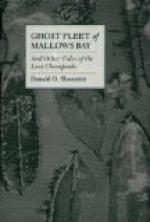They slipped away, with a feeling that, somehow, two very guilty people had been punished in those two. The negroes made the funeral procession. The Jew walked amongst the negroes.
“O Father Abraham,” he said, chuckling to himself, “forgive me that I stand here, no renegade to my faith, yet the only white Christian on Chincoteague!”
Issachar was oyster-man, sailor, and sutler in one. He advanced money to build pungy boats, knit nets, and make huts. He kept a trading place, packed fish, and dealt with the Eastern port cities by a schooner whose crew he shipped himself and sometimes commanded her. He was a wrecker, too, prompt and enterprising; passed middle life, but full of vitality; bold and cunning in equal degree; and he had been, it was guessed, a slaver, and some said a pirate. He was called by the negroes the King of Chincoteague. His schooner was named The Eli.
Chincoteague is the principal inhabited island along the one hundred miles of coast between the capes of the Delaware and of the Chesapeake—a coast of low bars, divided into long and slender islands by a dozen inlets, which, almost filled with sand, permit only light-draught vessels to enter; and it is destruction to any ship to go ashore on that coast, where five successive lighthouses warn the commerce of the Atlantic off, but are unable to intimidate the storms which sweep the low shores and almost threaten to leap over the peninsula and submerge it. Chincoteague lies like a tongue between two inlets, and partly protrudes into the sea, but is also sheltered in part by the bar of Assateague, whose light has flamed for years. Chincoteague is about ten miles long, and behind it an inland bay stretches continuously, under various names, for thirty miles, protected from the ocean, and scarcely flavored with its salt, except near the outlet at Chincoteague, where the oysters lie in the brackish sluices, and all sorts of fish, from shrimps to sharks, hover around the oyster beds. In the green depths they can be seen, and there the crab darts sidewise, like a shooting star. In the sandy beach grows the mamano, or snail-clam, putting his head from his shell at high tide to suck nutrition from the mysterious food of the sea, and giving back such chowder to man as makes the eater feel his stomach to possess a nobility above the pleasures of the brain. The bay of Chincoteague is five or six miles wide, and the nearest hamlet is in Virginia, as is Chincoteague island also. The hamlet takes the name of Horntown, and not far from there is the old court-house seat of Snow Hill, in Maryland. Every soul on Chincoteague was native there or thereabout, except Issachar the Jew.




